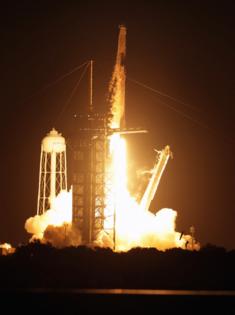NASA, SpaceX up timeline allowing Boeing Starliner astronauts to return sooner
Published in Science & Technology News
SpaceX and NASA, under pressure to get a pair of Boeing Starliner astronauts home sooner than later, announced Tuesday they have shifted plans for the next mission to the International Space Station.
The Crew-10 mission to the ISS is now targeting as early as March 12. Its four passengers are headed there to relieve the Crew-9 mission, which includes NASA astronauts Butch Wilmore and Suni Williams, who flew up to the ISS on board the Starliner but were left behind for safety reasons.
The duo have been on board the ISS since June 6, having arrived on Starliner’s Crew Flight Test mission that launched from Cape Canaveral last year.
What was supposed to be as short as an eight-day stay has now passed eight full months on board after NASA opted to send Starliner home without crew because of concerns over thruster failures and helium leaks in its propulsion module.
The Starliner astronauts were then assigned to ride home with SpaceX’s Crew-9 mission, which flew up to the ISS in September carrying only two instead of four crew, leaving open two seats for Williams and Wilmore for the eventual ride home.
But the ride home was still going to be a ways off, having to wait until Crew-9 completed its six-month mission, and departure only planned until after its replacement mission, Crew-10, arrived.
The problem is that SpaceX was looking to debut a new Crew Dragon on Crew-10, and it’s just not ready.
Delays to the vehicle had already pushed a planned February launch into late March, meaning Williams and Wilmore would not have a chance to fly home until early April.
With Elon Musk announcing last month that President Trump had asked SpaceX get the duo home “as soon as possible,” plans began to change up the spacecraft for Crew-10 so that it would instead use the Crew Dragon Endurance, which had been set aside for the private Axiom Space mission coming up later this spring.
Now Crew-10 is slated to launch as early as March 12 “pending mission readiness and completion of the agency’s certification of flight readiness process,” according to a news release from NASA.
That would allow Crew-9 to come home as early as mid-March, which would mean Williams and Wilmore will have spent about 9 1/2 months on board, but would get them back to Earth two or three weeks earlier than if NASA and SpaceX had stuck with plans to fly a new Crew Dragon.
“Human spaceflight is full of unexpected challenges. Our operational flexibility is enabled by the tremendous partnership between NASA and SpaceX and the agility SpaceX continues to demonstrate to safely meet the agency’s emerging needs,” said NASA Commercial Crew Program Manager Steve Stich in a press release. “We greatly benefit from SpaceX’s commercial efforts and their proactive approach in having another spacecraft ready for us to assess and use in support of Crew-10.”
This marks Crew Dragon Endurance’s fourth flight to space. It previously flew on the Crew-3, Crew-5 and Crew-7 missions.
The new Crew Dragon may not have been ready by the late March target date, but now SpaceX can spend more time getting it set for its debut flight. Its first mission has not been determined, but it could be tapped for the Axiom Space mission.
Crew-10 will fly up with NASA astronauts commander Anne McClain and pilot Nichole Ayers along with Japan Aerospace Exploration Agency (JAXA) astronaut and mission specialist Takuya Onishi and Roscosmos cosmonaut and mission specialist Kirill Peskov.
Wilmore and Williams will fly home as part of Crew-9 along with NASA astronaut and commander Nick Hague and Roscosmos cosmonaut Aleksandr Gorbunov.
The spacecraft is set to splash down off the coast of Florida, one of the last Crew Dragon flights to do so before SpaceX shifts Dragon recovery landings back to California this year.
_____
©2025 Orlando Sentinel. Visit orlandosentinel.com. Distributed by Tribune Content Agency, LLC.







Comments